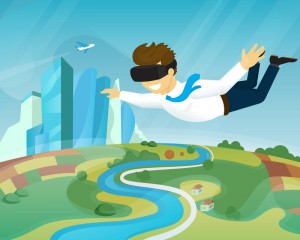Share This
Related Posts
Tags
Virtual Reality
By Anca Gagiuc on Apr 19, 2016 in Technology
Virtual Reality is on everywhere these days—videogames, engine ering, healthcare, entertainment—are just a few of the industries fuelings its evolution. More recently, VR entered the real estate market too.
ering, healthcare, entertainment—are just a few of the industries fuelings its evolution. More recently, VR entered the real estate market too.
Allured by its many advantages, developers turn to virtual reality and enable buyers to tour units, “walking” around mock layouts and peering out windows to envision the view they might wake up to every morning (this is where drones step in to capture accurate floor-by-floor perspectives). Instead of the full-sized models of one of the units, they can now use smaller sales centers equipped with a VR headset. No more selling off blueprints.
“Our whole business exists to work on spaces that don’t exist.” Jamie Fleming, CEO of Studio216
Such a development that used the VR technology to drive sales is Luma, a 24-story condominium development in Seattle. The sales team opted for an Oculus Rift headset and started offering tours of the property a little after the project had just broken ground. Studio216 of San Francisco is the digital production agency that created the simulated space for the Luma development and one of the firms currently involved in developing industry-specific application for the technology.
The virtual reality market is expected to explode over the next decade. According to a Goldman Sachs research, VR will be an $80 billion industry by 2025—the size of the current desktop PC market. The forthcoming consumer release of Oculus Rift headsets to the public might rapidly improve consumer adoption. However, real estate technology is far behind where it should be. A good exemplification is that there are still real estate firms still using Internet Explorer (sorry, Microsoft) as their main browser.
Using VR headsets to tour your future home, office or vacation rental is pretty straight forward: the agent connects the VR headset to a powerful laptop and hands you a joystick (you get to site while you “walk around” the property. It feels as if you’re in a video game and the scenery is not at all photo realistic, but you get to actually understand the apartment layout, experience the flow from one room to another, and even see what views you will buy along with the property.
As every nascent industry, the developing technology is far from perfect; moving too fast through the virtual space can be jarring and dizzying, some people feel sick after spending just a few minutes with the goggles.
At the moment, creating such a simulation requires 48 hours. Virtual Xperience, another company developing virtual reality content for the real estate industry, believes they can cut the needed time in half. Moreover, they expect the experience to become more realistic and relevant through co-evolution of content and technology.
There are different arrangements that real estate firms can request for their virtual model. For a typical 750 square-foot, 1-bedroom New York City apartment with balcony, the process will cost around $399-$799, said Virtual Xperience who has a team of designers who custom-design VR space. For larger properties, including multi-level single-family townhouses that more complex, the price will go up. Jeff Maurer, a partner at Virtual Xperience, believes this is in many ways a volume play—it is a big expense to sell a single-family home, but for an extensive apartment or condo building that have similar floor plans, there’s more return on the investment.
The possibilities are almost endless. Commercial property and sale centers can use the technology to show prospective buyers how a space can look and have them engage with the development far before it’s finished. At some point, there will be the possibility to test different layouts and see what appeals most to buyers. But first, more headsets need to be distributed.
More and more brokers and real estate agents see VR as an exciting tool, even though one that still needs plenty of development to reach its full potential. The photo-realistic views are not there (yet), but it is still a huge step forward from the “virtual tours” that populated real estate websites over the last decade.
So what is holding VR technology back?
Firstly, the limited availability of headsets. Secondly, the limited availability of computers that have the processing power to run high-end VR simulations. Of course, there is also the option to use the Samsung Gear VR headset, a more mobile technology that works with a smartphone.
“The issue is that there are so few displays out there, so distributing the content is currently a little bit challenging,” said Matthew Hood, a realtor at Sotheby’s International Real Estate. “The industry projections for the next few years suggest there will be millions of displays in the wild.”
